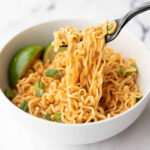by Buck Reed
Rocking Ramen
Ramen is on the rise. Given that it is an inexpensive dish that is easily elevated, it is understandable that we will be seeing it on more restaurant menus, and more Ramen shops will be opening soon. This elegant dish will no longer be relegated to broke college students. And, perhaps, more home cooks will be creating their own versions.
Ramen has a confusing origin, starting in the 5th century when a Chinese noodle was brought to Japan and became a popular dish. Chinese laborers immigrated to Japan and brought Lamen, a wheat noodle, from their country and was soon imported into the country. This noodle was renamed Ramen and soon became an integral part of a Japanese dish that fed the masses.
Toward the end of World War II, food was rationed in Japan, and with the war and its inherent problems, the rations were delayed sometimes for weeks. As a result, illegal Ramen shops were open for business. Business was so good that even the Yakuza got in on the action. After the war, rationing continued and so did the shops.
After the war, Momofuku Ando, a manufacturer who lost his business to the war, was wandering the streets of his bombed-out city and noticed the street vendors selling Ramen. This sparked the idea of the Ramen we are all familiar with today: the precooked block of noodles with the flavor packet. Although a very pale version of the traditional dish, it is still somewhat tasty, satisfying, quick, and, more importantly, economical.
Real Ramen might still be considered peasant food, but it is still a dish that demands a harmonic balance of five elements. These elements are:
Broth ~ If you cannot make your own, then pick a high-quality one that is sodium-free.
Tare ~ this is the seasoning and sauce that is used to flavor your dish.
Noodles ~ Chinese-style alkaline noodles will give you the correct texture. You might find them in the grocery store, but you might want to check the local Asian market for a better price and variety.
Topping ~ Meat, poultry, seafood, eggs, and vegetables are a great addition. Think of this as a chance to use up leftovers!
Oil or Fat ~ used to add depth and richness to the dish.
Ramen is one of those dishes that might take a day to learn but a lifetime to perfect. And given the harsh economic times and the need to be frugal, you might as well start sooner than later. Like most dishes, this one is less about being audacious and more about being flavorful, so do not be afraid to go for it.


